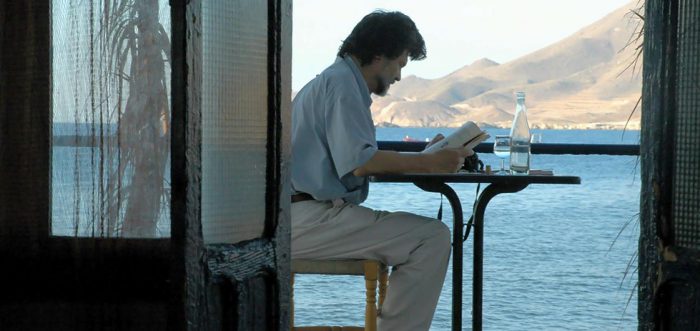
Filming intimacy, and garnering genuine empathy from the viewer, is notoriously difficult. The result is often tied to the form or genre at hand, with a conventional documentary being able to achieve the task in a more linear fashion. When the context of directing broadens itself into more abstracted, reflective cinema, this becomes a much harder task; one that Rita Azevedo Gomes attempts in her latest effort Correspondências. Jorge de Sena, a poet forced to leave Portugal for Brazil, as part of a 20-year exile from which he never returned, is the central focus throughout. Her more specific focus is Sena’s correspondence with Sophia de Mello Breyner Andresen; their “hours of conversation” through epistolary correspondence. Their back-and-forth letters are honest, revealing, and clearly the product of a rare relationship. At the same time, the way Correspondências visually articulates this—a mixture of dramatisations, confessions, and impressionistic visuals, with a two and a half hour duration—is bloated and exhausting, despite a handful of stunning moments.
The variety of film types and framing techniques is a clear mirroring of the dialogue that Gomes reflects on, from familiar cinematic footage to more theatrical indoor scenes. Confessionals and reflections are shot up close, with more abstract lyricism spoken over 4:3 shots of landscapes. Old footage of Delphi is shown, while Andresen reflects to de Sena on the extremes of the landscape. The theatrical scenes have a greater sense of drama and staging, with the depth-of-field portrayed much more starkly than in other scenes. In one of the more memorable shots, a figure in a suit sits silently on the ground while a boy plays cello. These experiments with space are continual throughout: a scene with letters laid on the ground, a mirror in the shot, a voiceover reading quickly shifts its environment as a figure, seen first in the mirror, enters the scene.
Correspondências navigates a fine line of obtuseness. While Gomes’ work is fractured, surreal, and at times gripping in its drifting quality, it is simultaneously a piece bogged down by mundanity, self-obsession, and abstraction. While alluring in parts, is overwhelmingly alienating and indistinguishable to those unfamiliar with the niche output of Andresen and de Sena. The film is littered with intimacy, yet it’s indecipherable at times when it is striving for purity. It’s clear that there is a genuine and beautiful relationship playing out in screen, and that would feel voyeuristic if not for the fact that the majority of the letters and visuals operate in a way that prevents it. Perhaps this intimacy is reserved for those most knowledgable about de Sena’s life and work. While this obtuseness is frustrating, there are clear moments of beauty throughout, although they feel scattered in the 2.5 hour work. Gomes’ film is original and bold by any measure, but the sacrifices it makes as attempt at conceptual purity, whilst astounding on many levels, makes it overwhelmingly alienating.
Correspondências is a film that feels at home at Locarno, with its complexities on display. At the same time, its presence at the festival recalls similar highlights from years past. Pedro Costa’s Horse Money, whilst less tied to reality, offered a more inspired reflection on life, distance, and history, while Albert Serra’s Story of My Death articulated a period of life with impressionistic flourishes. Both films offer greater coherency than Gomes’ latest work.
Gomes’ career as a filmmaker has frequently expressed as certain reverence for the flair of Romanticism; whether it’s her stunning theatrical adaptation of Barbey d’Aurevilly’s work in A Woman’s Revenge, or her earlier effort in nostalgic Frágil Como O Mundo. Both films communicated a certain cinematic strength from Gomes, defining her as a deeply literary and cognitive filmmaker. In many ways, the strengths of these early works beomce more realised in Correspondências, albeit more pure, and less accessible as a result. It is a film enamoured in a literary approach to cinema, with the poetry threaded throughout trying to tie together as much as it can. Correspondências is likely to be remembered amongst Gomes’ most divisive works, with fans of her ouvre (and the subjects of the film) likely to take the most from it. On the inverse of this, it’s one of the directors most inward-looking works, with those unfamiliar with Gomes likely to struggle throughout.
